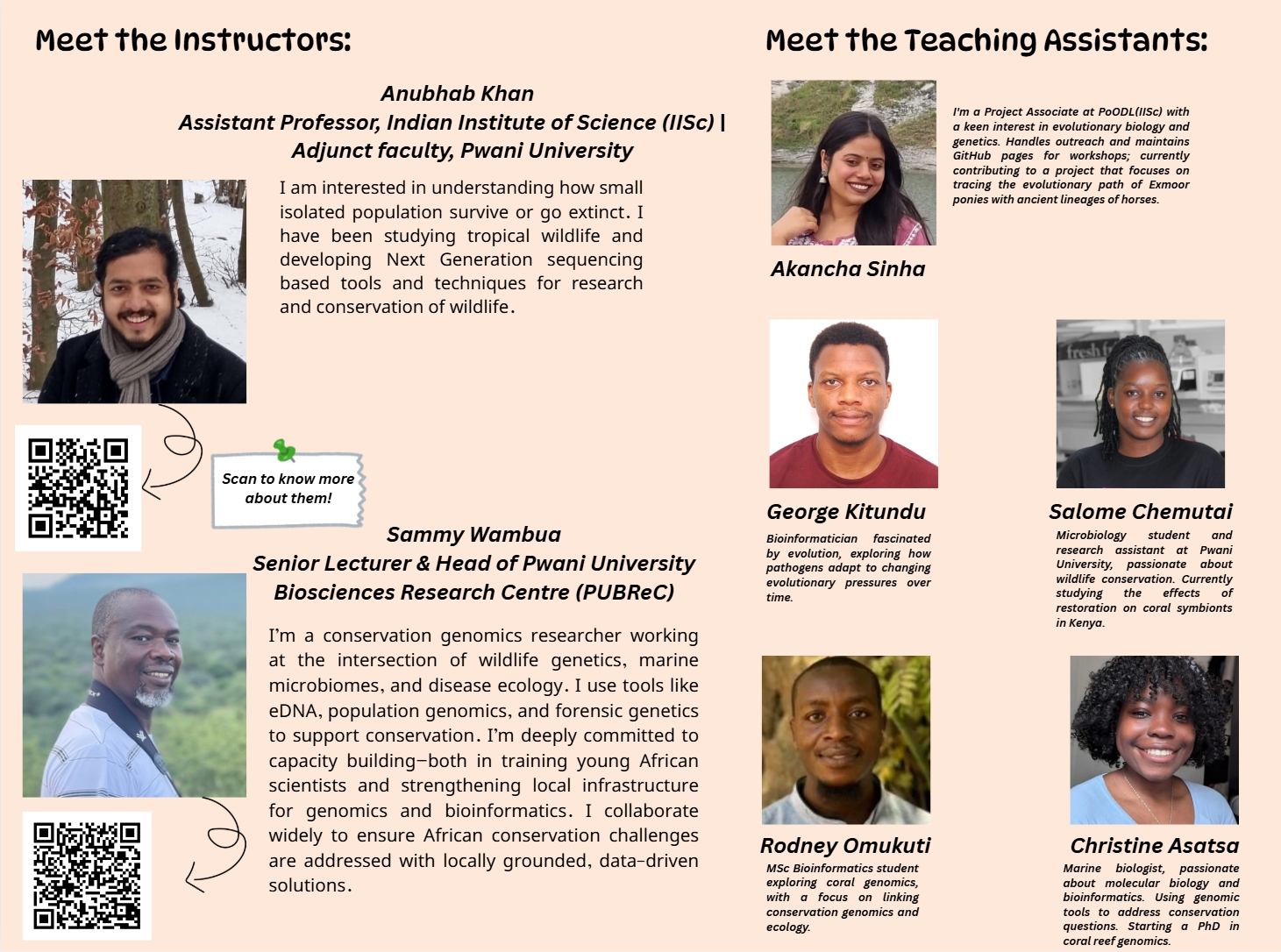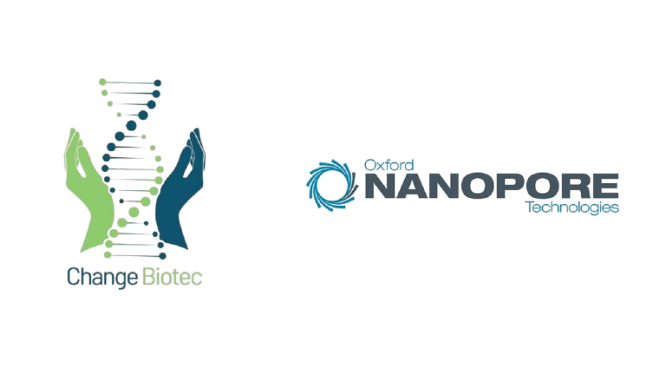
- This event has passed.
3rd Hands-On Wildlife Genomics Workshop
Welcome to Wildlife Genomics 3 workshop
Dive into the Wild World of Genomics and Metagenomics!
Join our interactive, hands-on workshop designed to equip you with cutting-edge tools and techniques in wildlife genomics and conservation biology. Whether you’re curious about decoding genomes to inform population management or exploring biodiversity through environmental DNA, this course offers something for everyone passionate about wildlife research and genetics.
On one track, delve into the fundamentals of Population Genetics and next-generation sequencing (NGS) data analysis including Illumina and Oxford Nanopore technologies. You will gain practical experience in analyzing genomic data for applications such as wildlife censuses, measuring genetic diversity, fitness and combating illegal wildlife trafficking. With workflows adaptable to RAD-seq, amplicon-seq, and more, if you’ve got a reference genome, you’re ready to go!
Alternatively, explore how Metagenomics and eDNA are revolutionizing wildlife monitoring. Learn how to extract meaningful insights from soil, water, feces, or blood meal samples to detect elusive species, trace pathogen outbreaks, map microbial communities, and uncover predator–prey relationships. These non-invasive techniques are ideal for challenging environments and ethically sensitive studies, offering powerful tools for ecosystem management and health surveillance.
Whether you’re a beginner or looking to expand your genomic toolkit, this workshop allows you to tailor your learning path—choose your focus or blend both worlds for a comprehensive understanding of modern wildlife genomics.

General Information
- Date: July 22- 04 August, 2025
- Location: Pwani University, Kilifi, Kenya
- Organized by: Pwani University and Indian Institute of Science (IISc)
- Price: Free
- Contact: s.wambua@pu.ac.ke, anubhabkhan@gmail.com
Workshop Objectives
🧬 Population Genomics Track
- Understand and process raw sequencing data (FASTQ format)
- Perform quality control and preprocessing
- Map reads to a reference genome
- Identify variants (SNPs and indels)
- Use filtered variants for basic population genetic analysis (PCA, Admixture, heterozygosity)
🧪 Metagenomics & eDNA Track
- Introduce participants to eDNA metabarcoding and shotgun metagenomics workflows
- Provide hands-on experience in field collection, DNA extraction, and library preparation
- Train participants in sequence quality control, taxonomic assignment, and diversity metrics
- Explore use cases in wildlife health, habitat quality assessment, and ecosystem monitoring
Take a look at our reproducible version of other workshops, available at: PoODL-CES Workshops
Preliminary Workshop Schedule
| Day | Population Genomics Track | Metagenomics Track |
|---|---|---|
| Day 01 | Welcome and orientation. Theory: Basics of genomics – Principles, Applications, and Opportunities. Sampling Techniques and Their Impact on Results. Planning sampling strategies. | |
| Day 02 | Fieldwork: Collection of environmental samples. Laboratory session: DNA extraction. Theory: Troubleshooting common issues in DNA extraction. | |
| Day 03 | Practical: Library preparation, DNA quantification and quality control, Sequencing. Theory: Sequencing Platforms, Overview of sequencing outputs and formats (e.g., FASTQ), applications of sequence data, sequencing strategies, Basic Linux and command line | |
| Day 04 | Theory: Introduction to population genetics, conservation genetics, evolution and genomics | Theory: Basics of Metagenomics – Principles, Applications, and Opportunities.Tools and Pipelines for Metagenomics |
| Day 05 | How to design your wildlife genomics project, Basic linux2, Accessing freely available data for research. | Practical: Setting up a bioinformatics environment (local or cloud-based). Theory: Introduction to raw data quality assessment (e.g., FastQC). |
| Day 06 | Mapping, SNP calling, SNP filtering (step 1). | Theory: Quality Control and Filtering of Sequencing Data, Introduction to taxonomic classification using databases (e.g., SILVA, RDP), Practical: Trimming and filtering data, Assigning taxonomy to sequences. |
| Day 07 | SNP filtering step2, Relatedness, PCA(Principal Component Analysis)and Admixture. | Theory: Functional Annotation and Pathway Analysis. Practical: Annotation using tools like Prokka or EggNOG-mapper, Visualizing functional data. |
| Day 08 | Measuring genetic diversity: Heterozygosity, Pairwise Nucleotide Diversity (pi) Allelic richness and Inbreeding. | Theory: Diversity Analysis – Alpha and Beta Diversity Metrics, Introduction to statistical tools for metagenomics (e.g., R, STAMP). Practical: Diversity calculations and visualizations, Statistical comparisons between samples. |
| Day 09 | Demographic history, why is it important? How to estimate it? PSMC, GONE. | Workshop: Interpreting taxonomic and functional analysis results. Case studies: Examples of published metagenomic studies. Group activity: Preparing a presentation on findings. Individual feedback and troubleshooting session. |
| Day 10 | Selection/load. How to measure it? Identifying deleterious alleles and signatures of selection. | Group presentations of results. Peer and instructor feedback. Discussion: Ethical considerations in metagenomics. |
Instructors

Pre-requisites & Setup
- Access to a Unix/Linux shell environment:
- Windows: Install MobaXterm
- Mac/Linux: Use native terminal
- Basic knowledge of Linux commands: Understanding Linux Commands .
- Pre-installed conda environments: Conda Environments.
Recommended Resources
Learn About Illumina and Oxford Nanopore Sequencing
Linux Shell Basics
Linux Shell Advanced
Other Linux tutorials
Population Genetics Workshop Pipeline Breakdown
1. Initial Processing of FASTQ Files
Objective:
Solutions File:
Includes quality check (FastQC), adapter trimming (Trim Galore/trimmomatic), and preparing cleaned reads.
- Check read quality (e.g.,
fastqc) - Trim adapters or poor-quality reads (
Trim-galore,trimmomatic) - Clean FASTQ files ready for mapping
Need help understanding a FastQC report? Click the image below to watch a short walkthrough that explains key sections of the report and how to interpret them.
2. Mapping Reads to Reference Genome
Objective:
Solutions File:
- Align with
BWAorBowtie2 - Convert SAM to BAM, sort and index using
samtools
Click the image below to watch a short walkthrough that explains BWA tool.
3. Identifying Variants (SNPs/Indels)
Objective:
- Call variants using
bcftoolsorstrelka - Generate a VCF file
- Optionally apply variant filtering
Click the image below to watch a detailed walkthrough that explains the variant calling process and how it fits into the genomic analysis pipeline.
4. Filtering Variants
Objective:
Solutions File:
Explanation:
- Variant Filter Descriptions.
- Apply filters with
bcftools,vcftools - Remove low-confidence variants
5. Population Structure & Visualization
Objective:
Solution:
-
- Convert VCFs to
.bed,.pedusingplink - Perform PCA to explore population structure
- Visualize and interpret clustering and outliers
- Convert VCFs to
Understanding PCA (Principal Component Analysis) : Click the image below to watch a clear and concise explanation of PCA — a key method for visualizing population structure and genetic variation.
Our Workshop Sponsors
We gratefully acknowledge the generous support of our sponsors who make this workshop possible. Their dedication to advancing genomic research and capacity building plays a vital role in wildlife conservation.






